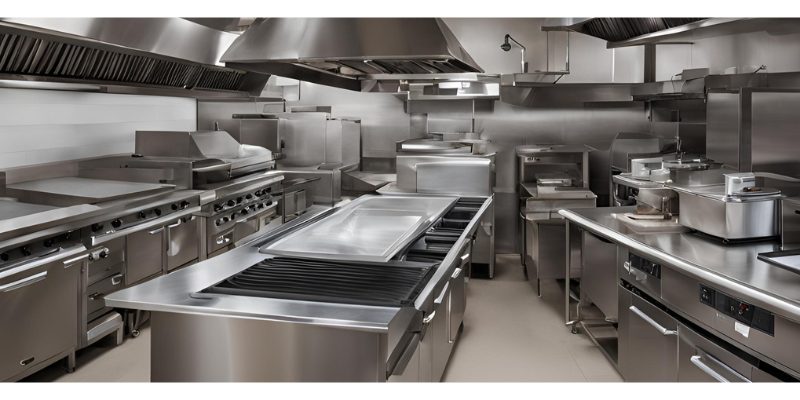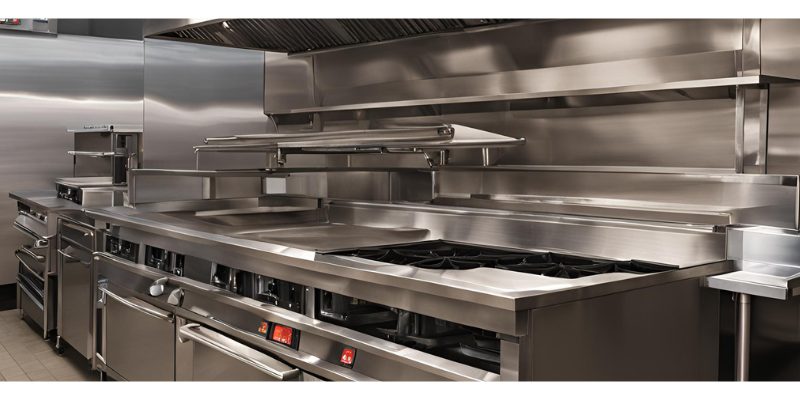Affordable restaurant equipment means the world to those opening a restaurant operation on a tight budget.
It is crucial to cutting costs in your commercial kitchen.
In this blog post, we will explore how restaurant owners can find the right balance between cost and quality when it comes to supplies and equipment for a restaurant.
Affordable Restaurant Equipment: Understanding Your Needs
Delving into the heart of your restaurant’s individuality is a foundational step in the quest for balancing cost-efficiency with quality in restaurant equipment and supplies.
This exploration requires a nuanced appreciation of various elements that define your culinary venture.
The cuisine you specialize in, for instance, dictates specific kitchen tools and ingredients, whereas the scale of your operation influences the quantity and diversity of supplies needed.

Understanding of your clientele’s preferences and expectations, can significantly affect your choice of dining ambiance and service style.
Recognizing these distinctive factors allows you to tailor your procurement strategy, ensuring that every dollar spent is a strategic investment towards enhancing your restaurant’s unique value proposition.
Whether it’s sourcing the perfect blend of spices for your signature dishes or selecting furniture that compliments your aesthetic, a keen awareness of your restaurant’s specific requirements is pivotal.
This strategic approach streamlines your purchasing process but also fortifies your brand identity, setting the stage for a memorable dining experience that resonates with your target audience.
Affordable Restaurant Equipment: Your Essential Checklist
Embarking on the journey of compiling an essential checklist for your restaurant’s supplies and equipment begins with a focus on both the backbone and the heart of your operations.
This involves kitchen essentials such as high-quality restaurant supplies and equipment that withstands the rigors of daily use, restaurant dinnerware, and reliable, energy-efficient commercial kitchen appliances that promise longevity and performance.
In the dining area, the importance of durable, aesthetically pleasing furniture cannot be overstated.
Moreover, critical to this list is the integration of technology solutions, such as advanced POS systems that ensure seamless service and inventory management tools that keep your operations running smoothly.
Additionally, considering eco-friendly options in your selection process not only aligns with sustainable practices but also speaks volumes to your clientele about your brand’s values and commitment to the environment.
As you curate this checklist, remember the balance between functionality and design, efficiency and sustainability.
Each item should not only serve its primary function but also contribute to the overall dining experience you aim to offer.
This detailed approach ensures that every piece of equipment and every supply selected plays a vital role in the symphony of your restaurant’s success.
Prioritizing Investments in High-Impact Areas
Navigating the landscape of restaurant management demands a strategic allocation of financial resources, especially when it comes to selecting which areas warrant more substantial investments.
High-impact areas are those that directly contribute to the operational efficiency and the gastronomic quality that your patrons come to expect.
This emphasis should be placed on procuring state-of-the-art commercial kitchen equipment that not only elevates the preparation and presentation of each dish but also stands the test of time, minimizing the need for frequent replacements or repairs.
Consider, for instance, investing in a high-efficiency oven that guarantees consistent cooking results or a robust food processor that can handle the demands of your busy kitchen.
Such investments, though initially more substantial, ultimately pave the way for smoother operations, reduced operational costs, and an enhanced dining experience.
It’s about making informed decisions that yield long-term benefits, ensuring that every dollar spent enriches the value you deliver to your customers and solidifies your establishment’s reputation for excellence.
Sourcing Strategies: Balancing Cost and Quality
In order to maximize your restaurant’s profits, you must first master the art of sourcing strategies, which requires a discerning eye that can identify value without compromising on quality.
Delving into the nuances of procuring affordable restaurant equipment, you must adopt a multifaceted approach that harmonizes cost-effectiveness with the unyielding pursuit of quality.
Engaging in practices such as bulk purchasing can unlock economies of scale, making high-grade supplies more accessible at a reduced per-unit cost.
Simultaneously, the dynamic of negotiating with suppliers unfolds as a pivotal skill, where the ability to forge mutually beneficial agreements can lead to advantageous pricing without diminishing the standard of goods received.
Venturing further, the strategic comparison of offerings from a diverse array of vendors empowers owners with the insight needed to make informed choices, ensuring that each acquisition aligns with the restaurant’s standards for quality and financial prudence.
This approach not only cultivates a landscape where excellence and affordability coexist but also propels the establishment towards a future where financial stability and superior culinary experiences are in constant synergy.
In navigating these waters, the astute restaurant owner becomes adept at threading the needle between cost savings and the unwavering commitment to delivering an exceptional dining experience.

Embracing Technology and Innovation in Your Purchasing Decisions
The relentless advancement of technology offers a beacon of efficiency and cost-effectiveness in the restaurant industry.
Venturing into the realm of smart appliances and digital systems presents an unparalleled opportunity to refine operations.
Innovative kitchen gadgets, equipped with the latest technology, not only enhance the culinary process but also ensure consistency and quality in every dish served.
The introduction of sophisticated POS systems revolutionizes the customer experience, streamlining orders and payments with impeccable precision.
Additionally, inventory management software becomes an indispensable tool, automating stock levels and reducing the risk of over-ordering or wastage.
This digital transformation extends beyond mere operational efficiency; it embodies a strategic investment in the future.
Embracing such innovations positions your restaurant at the forefront of the competitive landscape, promising not only immediate savings but also paving the way for sustained growth and profitability.
Leveraging technology in your purchasing decisions is not just about keeping pace with the times—it’s about setting the stage for enduring success.
The Hidden Value of Eco-Friendly and Sustainable Choices
Navigating the path toward sustainability in the restaurant supply chain is not only an environmental imperative but a strategic business decision that unveils hidden value.
Embracing eco-friendly practices and sustainable supplies, such as compostable packaging, transcends the conventional benefits of cost savings.
These choices serve as a testament to your brand’s commitment to stewardship of the environment, resonating deeply with a growing demographic of diners who prioritize eco-consciousness in their dining choices.
Moreover, implementing sustainable practices often leads to operational efficiencies, such as reduced energy expenses or decreased waste management costs, thereby enhancing overall profitability.
Additionally, the investment in sustainable technologies and materials signals to both customers and employees alike that your establishment is forward-thinking, innovative, and responsible—a distinction that can elevate your restaurant’s reputation and customer loyalty.
The adoption of these practices, therefore, is not merely about compliance or cost—it’s about seizing an opportunity to differentiate your brand, engage with your community, and contribute to a larger, global effort of environmental preservation.
Building Relationships with Restaurant Suppliers for Mutual Benefit
Fostering robust partnerships to source affordable restaurant equipment transcends mere transactional exchanges; it’s a strategic move towards cultivating a sustainable ecosystem for your restaurant.
Engaging in open dialogues and showing genuine interest in your suppliers’ challenges and successes paves the way for a rapport based on trust and mutual respect.
This alliance allows for the exploration of customized solutions tailored to your restaurant’s needs, potentially unlocking preferential pricing structures, access to premium-quality goods, and insights into industry innovations before they hit the wider market.
Negotiations then become conversations about shared growth, where both parties are invested in the long-term success of each other’s business.
Embracing this collaborative approach not only secures your supply chain but also enriches it, ensuring that your restaurant is always equipped with the best resources at the most advantageous terms.
Through this symbiotic relationship, the goal of achieving cost-effectiveness without compromising on quality becomes a shared vision, laying a solid foundation for enduring prosperity.

Regular Review and Optimization of Your Inventory
The rhythm of your restaurant’s heartbeat is its inventory – a well-orchestrated symphony of supplies and equipment that demands constant vigilance and fine-tuning.
The ongoing process of reviewing and optimizing your inventory is not merely an operational task; it’s a strategic endeavor that significantly influences your bottom line.
Embrace a methodology that involves diligent tracking and analysis of your inventory levels.
This practice allows for the identification of patterns, such as seasonal fluctuations or shifts in consumer preferences, enabling you to adjust your purchasing decisions proactively.
Efficiency is achieved not by chance, but through the deliberate actions of minimizing redundancies and eliminating items that no longer serve your menu or operational goals.
Such a streamlined approach not only curtails unnecessary expenditure but also enhances the agility of your operations, ensuring you can swiftly respond to the ever-evolving market demands.
By fostering a culture of continuous improvement in your inventory management practices, you position your restaurant to thrive, balancing cost-effectiveness with the unwavering commitment to quality that distinguishes your establishment in the competitive culinary landscape.